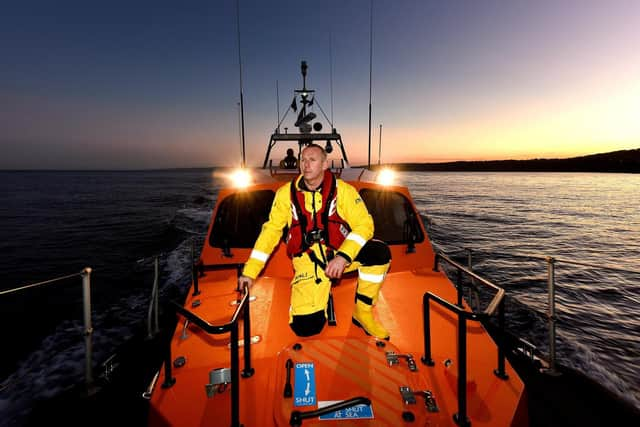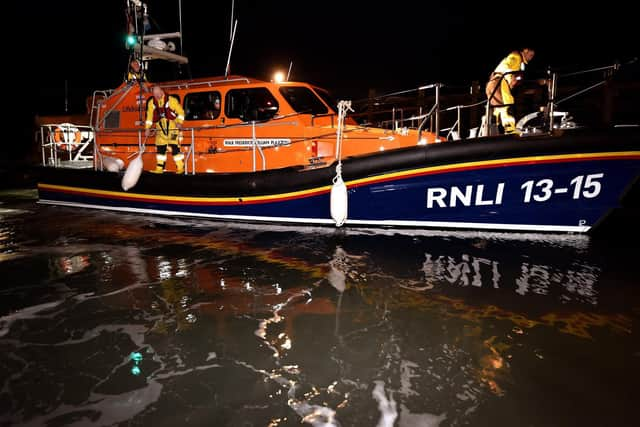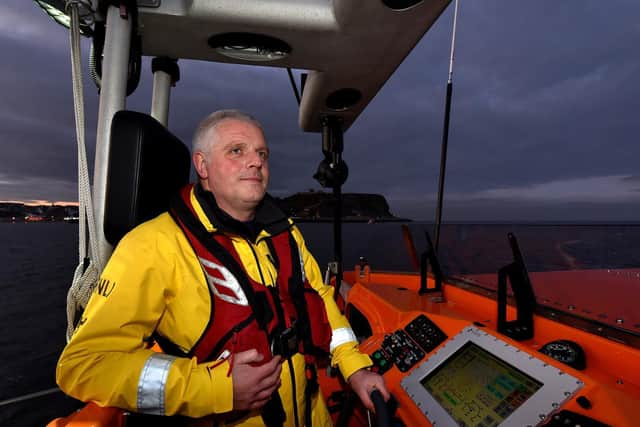Riding the waves with Scarborough lifeboat volunteers
and live on Freeview channel 276
When we think of Scarborough RNLI the first things that come to mind are the lifeboathouse and its new and shiny lifeboat. However, one thing that often goes unnoticed, or unpraised, is the dedication of those who use their time, often time that could be spent with family and friends, to train to save lives at sea.
On our visit to Scarborough RNLI, and our trip on board the Shannon, that dedication is exactly what we saw.
Advertisement
Hide AdAdvertisement
Hide AdTo get an insight into how the station operates, photographer Richard Ponter and I met the crew ahead of one of their training exercises. The crew alternate shore-based training with training at sea every other week. Almost all of them are volunteers, meaning they do this alongside their full-time job.


After greeting coxswain Wave Crookes in the crew room on the first floor, we’re swiftly escorted back downstairs where four members of the crew are gearing up ahead of boarding the lifeboat. As we too are to get on board, we’re given salopettes and lifejackets to wear on top of our normal clothes, and wellies to change into. While the kit is quite bulky, it’s also surprisingly light, allowing you to move as freely as possible.
After a short briefing from the coxswain, updating us on the purpose of our trip and the weather conditions we’re going to sail in, we’re all ready to board the Shannon, the RNLI’s latest and fastest all-weather lifeboat.
“Drop the mast, make sure everything is secure on deck, take a seat and off you go,” says Wave when I ask what happens before launch.
Advertisement
Hide AdAdvertisement
Hide AdAfter all, launching this £2.2 million, 13-metre lifeboat is relatively simple. Its Shannon Launch and Recovery System includes a tractor unit and a carriage. The bed of the carriage is lifted at one end by hydraulic pumps which allow it to form a slipway which in turns allows the lifeboat to slide down the carriage and into the water.


As I make my way inside the vessel and sit in a seat normally reserved for a doctor, I’m immediately told to strap myself in.
“This boat does 25 knots in all weathers so when you’re going at full speed to rescue a boat 60-65 miles away it can get quite violent.”
Luckily for us, we couldn’t have picked a better day; flat sea, clear sky and just a gentle breeze, so soon after setting sail towards North Bay – our trip involves going there and back – I’m able to get out on the deck and chat to some of the volunteers.
Advertisement
Hide AdAdvertisement
Hide AdOne of them is 39-year-old Kyle Patel who tells me about the RNLI’s competence-based training.


“Everyone has a plan that you work through and it depends on the unit. Radar, towing, anchoring, they’re all units so you pick one and train in that one.
“Once you’ve finished training you get assessed and the unit goes orange which means you’re ready for the actual assessment, so a couple of months down the line someone will assess you and if you pass it goes green.”
In the past five years, Kyle has trained to be a crew member on both lifeboats and a helmsman on the inshore. He’s now halfway through his training to become a navigator on the Shannon. Inspiring him to join the RNLI was his wife’s family’s connection with the charity. As some members of her family served with Filey lifeboat “it seemed the natural progression for me”. So far he reckons he’s attended well over 50 call-outs, including two on Christmas Eve.
Advertisement
Hide AdAdvertisement
Hide AdFellow crew member David Horsley, 55, is a full-time station mechanic and has been part of the crew for 15 years.
“We all rely on the RNLI being there, it’s just one of those things we take for granted,” he said.
As a station mechanic, David is responsible for making sure the lifeboat is always maintained and ready to go.
He works 37 hours a week and the rest of the time he’s on call, meaning he has to be within 10 minutes from the lifeboat station.
Advertisement
Hide AdAdvertisement
Hide AdAlthough he admits this does impact on family and friends, it’s something those around him have come to terms with.
As we arrive into North Bay and it’s time to head back I’m given the chance to drive the Shannon.
Having never driven a boat before, let alone a lifeboat, Wave is by my side, making sure we keep away from rocks and pleasure boats.
As he explains, the Shannon is propelled by waterjets which allow it to operate in shallow waters and approach stranded vessels or hazards with extreme precision.
Advertisement
Hide AdAdvertisement
Hide Ad“[The Shannon] is perfect for us, it’s not too big, not too small, it’s very agile and easy to manoeuvre. It’s exactly what we need in Scarborough.”
Before we know it we’re at the harbour where we agreed to get dropped off.
While me and Richard comment on what a great time we’ve had and thank the crew for their kindness, I find myself thinking that while we have reached the end of our working day, Wave’s crew are going back out to sea. For them, work starts now.
'Love Your Lifeboat'
On Saturday February 15 Scarborough RNLI will host a Love Your Lifeboat event, from 10am to 4pm, to raise funds for the station.
Advertisement
Hide AdAdvertisement
Hide AdThe Valentine-themed fundraiser, which last year proved very popular, will feature activities and games in the crew room on the first floor as well as tours of the station and on board the Shannon in exchange for a small donation. Tea, coffee, juice and biscuits will be served. There will also be a tombola. Everybody is welcome to attend and show their support to the crew.
Due to the growing demand on services and the financial challenges faced by lifeboat stations up and down the country, the RNLI is also encouraging members of the public to be generous and support its Perfect Storm appeal.
To make a donation which will go towards updating the equipment and facilities used by volunteers click HERE or phone 0300 300 0107.